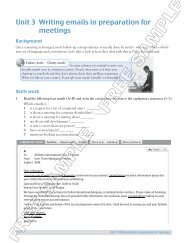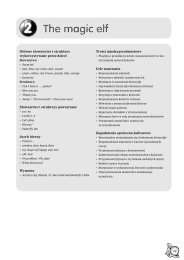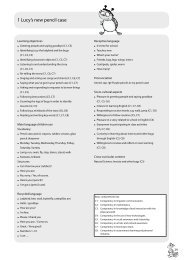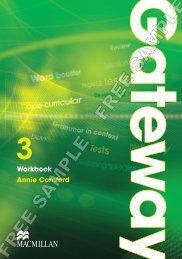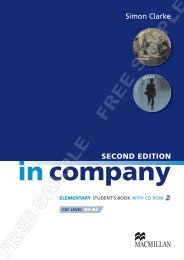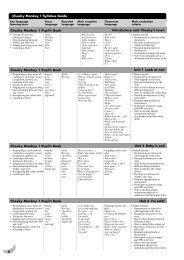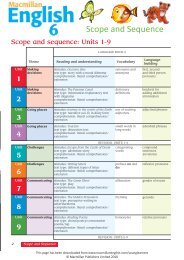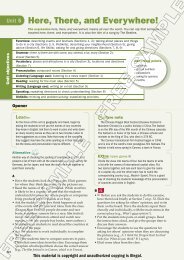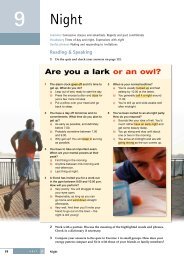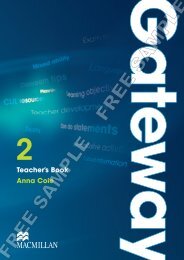You also want an ePaper? Increase the reach of your titles
YUMPU automatically turns print PDFs into web optimized ePapers that Google loves.
UNIT 1A balanced dietWe must eat the correct quantity <strong>and</strong> mixture ofdifferent food types to stay healthy. This is calledeating a balanced diet.A balanced diet contains carbohydrates, proteins,some fat <strong>and</strong> plenty of fresh fruit <strong>and</strong> vegetables richin vitamins <strong>and</strong> minerals.Lesson 3When you have completed thislesson you will be able to:• explain what is meant by abalanced diet• plan a menu to provide abalanced diet that includes allthe important food groups• describe the importance ofwater in the dietA c t i v i t y 1Make a list of the food you ate yesterday.1. Did you eat any animal protein (meat or fish)?2. Did you eat any carbohydrates such as potatoes or rice?3. Did you eat any fats, such as butter or cream?4. Did you eat any fresh fruit <strong>and</strong> vegetables?Look at these three meals. Identify the different nutrients they contain.Which meal contains all five?milkaapplepapayaorangejuicebbreadsweetpotatowatercgreenvegetablecarrotsbananatomatoriceplantainsteamedfishIn wealthy countries food-related health problemsare usually caused by eating too much food, eatingthe wrong kinds of foods <strong>and</strong> by lack of exercise.In developing countries many people do not haveenough to eat. As much as 60 per cent of the world’spopulation struggle to survive on a diet short ofcarbohydrates, protein, minerals <strong>and</strong> vitamins.Living things: Human body17
UNIT 1Lesson 3: A balanced dietA c t i v i t y 2Draw a chart like this to plan your meals for the next three days. Work with a partner.You should make sure you eat some protein, carbohydrate, a little fat, fresh fruit <strong>and</strong>vegetables each day. Do not eat the same foods every day.Meal Day 1 Day 2 Day 3BreakfastLunchEvening mealDiscuss your menu with your teacher. Is it a balanced diet?It is not necessary that every meal contains all five nutrients, but you should eat fromeach of them every day.The importance of water inthe dietAs well as food, your body needs water.You could survive for many days withoutfood, but without water you would die injust a few days. This diagram shows somedifferent uses for water in the body.To stay healthy the level of water in ourbodies must stay the same. We have tobalance the amount of water that passesout, with the amount taken in. If we donot have enough water we becomedehydrated.Fascinating factMarathon runners can loseup to 6 litres of waterduring a race in hotconditions. They must keepdrinking during the raceor they will collapsefrom dehydration.18 Living things: Human body
UNIT 1Lesson 3: A balanced dietA c t i v i t y 31. List five uses for water in the body.2. List the ways that water enters the body.3. List the ways that water leaves the body.4. Add up the water losses. Is this person’swater in balance? Explain why.This table shows that an average adult takes in about 2.6 litres of water a day. This watercomes from drinks, moist food <strong>and</strong> by breaking down food in the body.Water intake in cm 3 Water losses in cm 32600urine 1500sweat 600breathing out 400faeces 100What you have learntA ____ ____ provides the correct mixture of nutrientsto keep the body in good health. We should eat fromeach of the five nutrients every day. Fresh fruit <strong>and</strong>vegetables are an important part of a balanced diet.Water is an essential part of the diet. If you do notreplace water lost through urination, sweating <strong>and</strong>other routes, the body becomes ____.Key wordsbalanced dietdehydratedCheck your progress1 Explain what is meant by a balanced diet.2 Give an example of a meal that contains all five nutrients.3 Explain why the adult body needs to take in at least 2.6 litres of water each day.Living things: Human body19
UNIT 1<strong>Food</strong> <strong>and</strong> energyA c t i v i t y 1A peanutc<strong>and</strong>leWhen you eat apeanut, the chemicalsproduced by digestionare slowly ‘burnt’in your body. In thisprocess they releaseabout the sameamount of energy asthat released by thefl ame of a burning nut.Comparing the energy contents of foods• St<strong>and</strong> the c<strong>and</strong>le on the s<strong>and</strong> <strong>and</strong> light it.• Use the tongs to hold each food sample (a whole nutor a similar sized piece of cheese, bread or chocolate)in the flame. Observe whathappens <strong>and</strong> record yourobservations in a table.The food may bubble <strong>and</strong>melt at first. Moist food willsteam. Eventually most foodsamples will catch fire <strong>and</strong>foodcarry on burning when takenout of the flame.• Compare the different foods.Which burns longest? Whichproduces the biggest flame?Which types of food doyou think contain the mostenergy?tongsLesson 4When you have completed thislesson you will be able to:• investigate the energy contentof foods• state (in calories) the normalenergy needs of the humanbody• interpret the <strong>nutrition</strong>alinformation provided by thelabels on packaged foodsYou will need:food samples (nuts,hard cheese, dry bread,chocolate), kitchentongs, a c<strong>and</strong>le, a metaltray fi lled with s<strong>and</strong>.c<strong>and</strong>les<strong>and</strong> trayfoodsamples20 Living things: Human body
UNIT 1Lesson 4: <strong>Food</strong> <strong>and</strong> energyBeing a good scientist (science skill – measurement)Good scientists measure the things they observe to make their comparisons reliable.You could try to measure the amount of heat given out by the different foods,perhaps by seeing how much the burning sample will raise the temperature of acertain amount of water. This is a difficult experiment to perform accurately, butyour teacher may demonstrate how it might be done.<strong>Food</strong> scientists measure the energy in foods by burning them inside a special containercalled a calorimeter. They fi nd the heat released by the rise in temperature. Fats <strong>and</strong> oilsare the most energy-rich foods, with 900 calories of energy per 100 grams (g) of food.Carbohydrates <strong>and</strong> proteins contain about 400 calories per 100 g. The number of calories inthe food you buy in shops <strong>and</strong> supermarkets is shown on the packaging.Eating for energyDepending on what you eat, the energy needs of your body may be provided bycarbohydrates, fats or proteins. Ideally, most of the energy should be provided bycarbohydrates, since it is wasteful for the body to break down protein <strong>and</strong> fat for fuel.A resting human body needs about 1 calorie of energy per minute (this equals 1440 calories a day) to keep its basic life processesgoing. As your activity level increases, so do your energy needs. Vigorous sport uses up 10 to 20 times more energy than resting.Most adults require somewhere between 2000 <strong>and</strong> 3000 calories per day to maintaina steady body weight. An active, growing teenager needs a similar number of caloriesper day.Living things: Human body21
UNIT 1Lesson 4: <strong>Food</strong> <strong>and</strong> energyThe energy content of packaged foods is shown on the food label. The label also providesother <strong>nutrition</strong> information such as the fat, fi bre <strong>and</strong> salt content of the food.A c t i v i t y 2Make a collection of food labels from packaged foods. Which foods contain the mostcalories per 100 g? Which have the most fat? Which have the most salt?Fascinating factOne calorie is the amountof heat energy needed toraise the temperatureof 1 litre of water by 1degree Celsius (1°C).What you have learntDifferent foods provide different amounts of ____.Scientists measure the energy content of foods byburning them in a ____. When you are resting, yourbody needs about one ____ of energy per minute. Yourenergy needs increase when you are active. Fats <strong>and</strong>oils are the most energy-rich foods. The energy contentof packaged foods can be found on the ____ ____.Key wordscalorie calorimeterenergy food labelCheck your progress1 How many calories are contained in 100 g of fat?2 How many calories does an active teenager require each day?3 Predict what will happen if you eat too many calories each day.22Living things: Human body
UNIT 1DigestionThe food you eat is digested as it passes throughyour alimentary canal. Digestion is the process inwhich food is broken down into simpler substancesthat your body can use.Lesson 5When you have completed thislesson you will be able to:• describe how food movesthrough the alimentary canal• explain how food is digested<strong>and</strong> absorbed as it passesthrough the digestive systemFascinating factYou can swallow food when you are lyingdown, or even when you are hangingupside down. Astronauts can swallowfood in space. These observationsprove that the food is not just pulleddown by the force of gravity.The alimentary canal is really just a longtube with your mouth, the entrance, atone end, <strong>and</strong> your anus, the exit at theother. If you laid out this tube in a straightline it would be about 7 metres (m) long.When you swallow a ball of food it beginsits journey from one end of this tube to theother – but how does it move?A c t i v i t y 1Investigating movement through thealimentary canal• Use the tape to measure a 7m length ofhose. This is the length of your alimentarycanal.• Can you make the marble move throughthe tube? How can you use your h<strong>and</strong> tomake it move in either direction?You can make a marble move along the tubeby squeezing the tube just behind it. Balls offood move through the alimentary canal injust the same way.You will need:a tape measure, a hosepipe, amarble slightly bigger than theinside diameter of the pipe.gulletfoodmuscles squeezeThe walls of the alimentary canal contain muscle tissue. They move aball of food along by squeezing behind <strong>and</strong> relaxing in front. It’s a bit likesqueezing toothpaste from a tube.Living things: Human body23
UNIT 1Lesson 5: DigestionDigestionDigestion starts in the mouth when you chewfood <strong>and</strong> mix it with saliva. Saliva contains aspecial chemical called an enzyme, whichbreaks starch into sugars.When you swallow the food, it passes fromyour mouth into your stomach through thegullet. The stomach can exp<strong>and</strong> to take all thefood you eat during a meal.Inside the stomach, food is mixed with gastricjuices. These contain acid, which kills bacteria,<strong>and</strong> different enzymes that start to digestprotein.<strong>Food</strong> stays in the stomach for two to threehours, <strong>and</strong> then passes into the small intestine,where more enzymes complete the digestion process.gulletstomachsmall intestinelarge intestinerectumanusAbsorptionThe walls of the small intestine are covered with tiny folds. Thesecontain blood vessels into which the digested food passes. Thefolds increase the surface area, making it easier for substances topass through.Undigested food passes into the large intestine. There are a lotof bacteria here, which continue to digest food remains, oftenproducing lots of gas. Water <strong>and</strong> minerals are absorbed from themixture through the large intestine walls.As the contents of the largeintestine move down into therectum, they form into faeces.Faeces consist of water, bacteria<strong>and</strong> undigested food in aboutequal amounts. The faeces arestored in the rectum until they passout of the body through the anus.A c t i v i t y 2Answer these questions.1. What job does the stomach do?2. Where are most digestion products absorbed?3. What happens to water in the large intestine?Please see overmatter24 Living things: Human body



